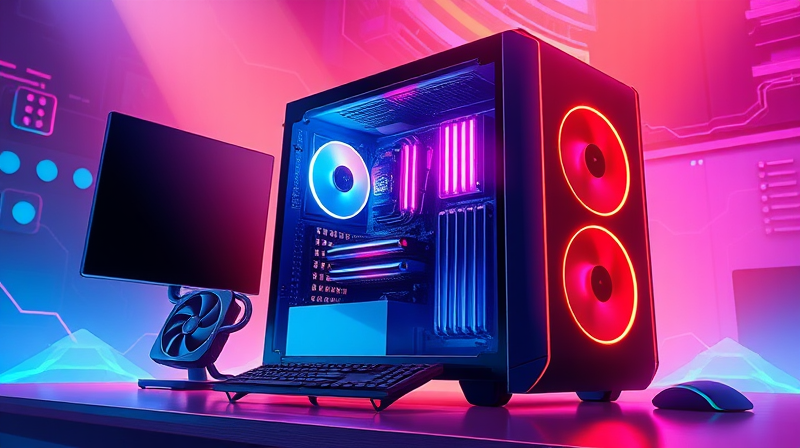Upgrading your PC doesn’t need to be a daunting or expensive task. By making informed decisions and focusing on the right components, you can see a significant performance boost without overspending. This guide will walk you through several key areas to consider for elevating your system performance while keeping your budget in check.
Enhance your overall computing experience by realizing that every upgrade, no matter how small, contributes to better performance, smoother gaming sessions, and improved productivity. With the right choices, even users on a budget can build a system that stands strong against future demands.
Key Upgrade Areas to Consider
Before diving into component specifics, it’s essential to understand that targeting upgrades strategically is the key to success. Rather than trying to do everything at once, assess which parts of your PC need the most attention. This not only ensures maximum performance gains but also helps you allocate your spending effectively.
Consider the following upgrade components:
- Graphics Card: Upgrading your GPU can make or break your gaming experience. Affordable options like the Intel Arc B570 provide robust 1080p graphics without straining your budget. If you can invest a little more, models like the AMD Radeon RX 7600 deliver exceptional performance with high frame rates.
- Processor (CPU): A new CPU can improve both gaming and productivity tasks. For those on a tighter budget, the Intel Core i3-14100F is an effective choice, while the AMD Ryzen 5 7600 provides a greater boost for slightly more investment.
- Memory (RAM): Moving up to 16GB of RAM is increasingly seen as the minimum for smooth operation. For those longing for future-proof functionality, upgrading to 32GB of DDR5 can be a smart long-term investment.
- Storage: A fast SSD drastically reduces loading times and streamlines day-to-day tasks. A 1TB PCIe 4.0 NVMe SSD, such as the WD Black SN770, strikes a great balance between capacity and speed.
- Cooling Solutions: Managing heat is critical to extract the best performance. While stock coolers offer basic service, an affordable upgrade like the Thermalright Peerless Assassin 120 SE maintains optimum temperatures and quiet operation.
- Case and Airflow: A budget-friendly case with features such as mesh fronts promotes better airflow. Options like the Thermaltake Versa H18 are perfect for balancing aesthetics and functionality without a high price tag.
- Power Supply: Don’t overlook the importance of a reliable PSU. Investing in a quality 650W 80+ Bronze certified power supply ensures stability and leaves room for future enhancements.
By focusing on these areas, you build not just for today but for the future. Every upgrade matters and supports a system that can grow with your needs.
It’s important to always check component compatibility before making a purchase. Researching user reviews, consulting community forums, and referring to compatibility lists can prevent mismatched components, ensuring your new upgrades function harmoniously with your existing system.
For many PC owners, the pressure to continually upgrade can be overwhelming, but understanding that you can achieve meaningful improvements through selective upgrades is both empowering and inspiring. Emphasize the importance of a balanced build that considers all aspects of performance, which means that while a powerful GPU is essential for gaming, equally robust CPU, memory, and storage help create a more versatile system.
When planning your upgrade path, set realistic goals and a budget that reflects your immediate needs. Do not feel compelled to buy the latest high-end hardware if your current usage does not demand it. Instead, target improvements that will make your everyday PC experience more enjoyable. Whether it’s improved gaming frame rates, smoother video editing, or simply a system that boots up quickly, every upgrade brings you a step closer to that goal.
It’s also worth considering second-hand or discounted components for those who are particularly budget-conscious. Many times, previous generation hardware can offer impressive performance at a fraction of the cost, allowing you to save money while still enhancing your PC’s capabilities.
Another helpful tip is to spread out the upgrades over time. Instead of replacing every component at once, prioritize immediate performance bottlenecks and gradually upgrade additional components. This approach not only makes the financial commitment more manageable but also provides regular improvements that keep you motivated.
For users who emphasize gaming performance, the graphics card upgrade typically provides immediate benefits. However, if your focus extends to activities like video editing or multitasking, investing in a better CPU or additional RAM could prove even more beneficial. Whichever path you choose, strategic upgrades can transform your PC into a powerhouse that meets both your gaming and professional needs.
Ultimately, building a quality PC on a budget is a journey of learning and adaptation. Every upgrade is an opportunity to understand your system better and to tailor it uniquely to your requirements. Embrace the process as a project that not only enhances your machine but also deepens your knowledge about technology.
Remember, the key to success is planning. With careful research and a clear upgrade plan, you can enjoy a high-performance PC that serves you reliably for many years. Let your upgrades be a testament to the adage that smart choices pave the way for impressive results.
Embrace the challenge of upgrading within a budget and see it as an exciting opportunity rather than a financial burden. With a little patience and a lot of determination, your dream system is within reach, showing that innovation and efficiency are often grounded in simplicity and thoughtful planning.








